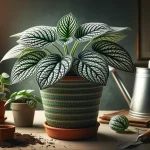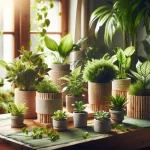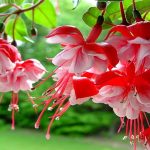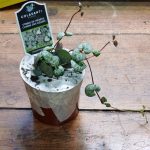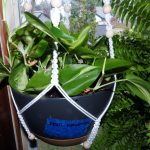This post may contain affiliate links. If you buy something from one of our links we may earn a commission. Thanks
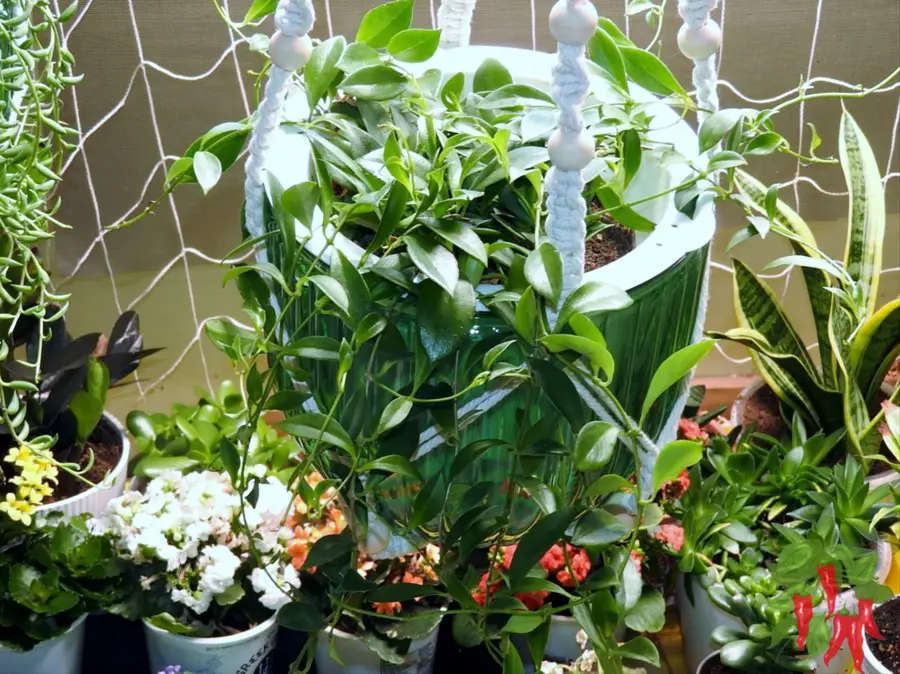
Purple Star Lipstick Plant care doesn’t have to be a mystery. If you’ve ever struggled with tropical plants that get fussy or fade too fast, this one’s a refreshing change.
With the right light, a little moisture, and a self-watering setup, this showy trailing beauty will thrive—and maybe even surprise you with its bold blooms.
Purple Star Lipstick Plant Care Key Takeaways
- Purple Star Lipstick Plant care is simple: give it bright, indirect light.
- Keep soil lightly moist using a well-draining mix like coco coir.
- Feed monthly in spring and summer.
- Use self-watering planters to maintain consistent moisture.
- With the right conditions, this tropical houseplant rewards you with long vines and striking red-violet blooms.
I. An Introduction to Purple Star Lipstick Plant Care
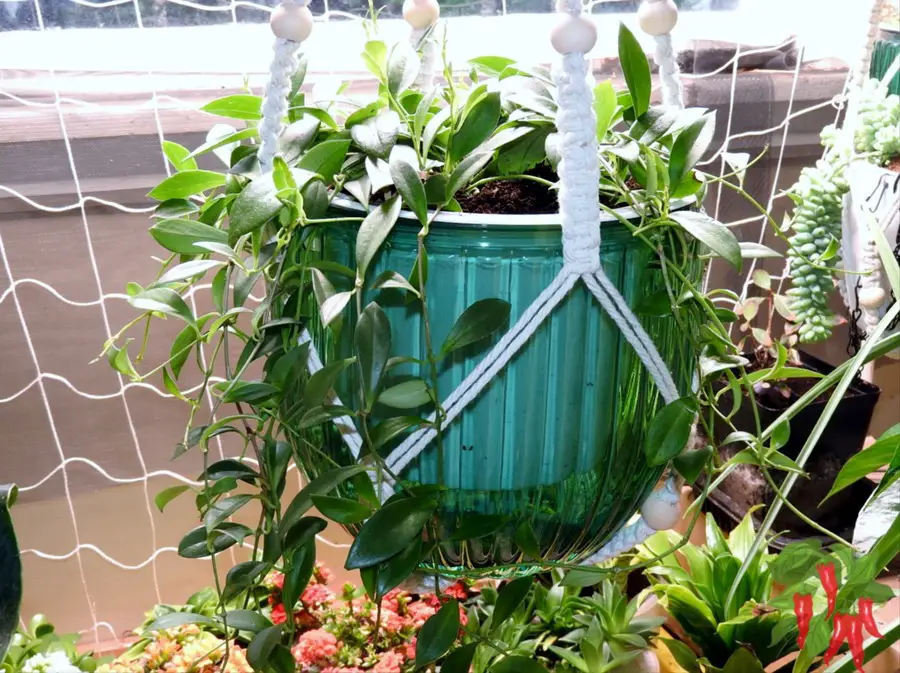
Overview of the Purple Star Lipstick Plant
Well, howdy folks. If you’ve never heard of the Purple Star Lipstick Plant, you’re in for a treat.
This beauty showed up in a six-inch nursery pot from California Tropicals, and I gotta say, I was blown away by the long, trailing vines straight out of the box.
It’s already got that “hang me up and admire me” vibe going strong.
 Purple Star (Lipstick Plant) – 6” from California Tropicals
Purple Star (Lipstick Plant) – 6” from California Tropicals
The plant gets its name from the flower buds, which form long tubes with red or in this case, possibly violet tips that really do look like a tube of lipstick.
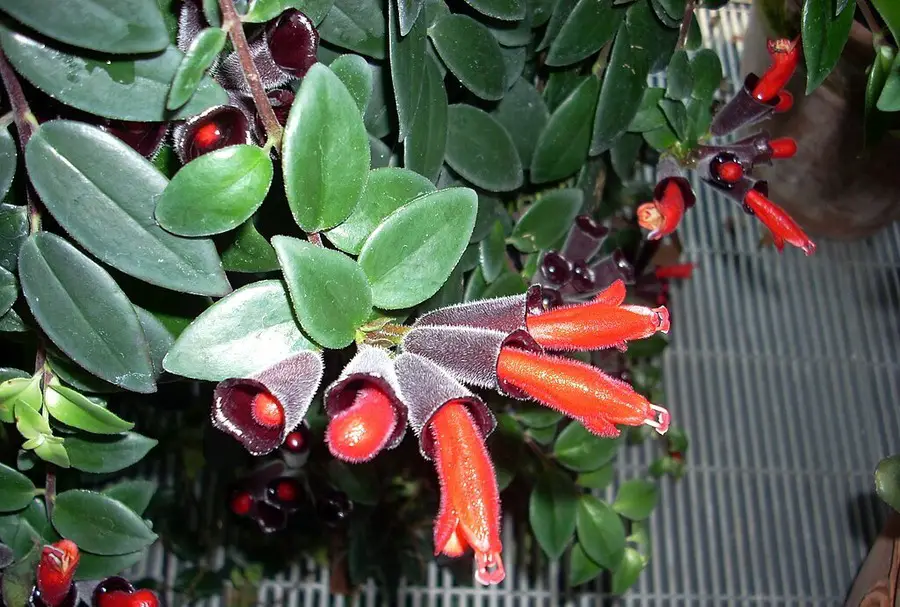
I haven’t seen it bloom just yet, but with spring on the way and a little extra light, I’ve got a feeling it won’t be long before it shows off.
Popularity as a Houseplant
Now, this isn’t one of those plants everyone has on their windowsill and that’s part of the charm. The Purple Star Lipstick Plant feels a little more special.
It’s got lush foliage, fast-growing vines, and it comes practically ready to display in a hanging basket or trailing over a shelf.
I think more folks should know about this one, which is exactly why I’m sharing it with you.
I’ve already potted mine into a self-watering Melphoe planter (more on that later), and it’s settling in nicely.
So if you’re looking for a houseplant with unique character and easygoing care needs, stick around. This one just might earn a spot in your collection too.

Melphoe Self Watering Hanging Planters for Indoor Plants, 1 Pack 8.3 Inch Outdoor Hanging Plant Pot Basket, 2 Kinds of Hangers Macrame 35.5’’ & Metal Chain 19.6’’ for Garden Home Decor
II. Lipstick Plant Varieties
There’s a whole world of lipstick plants out there, and while the Purple Star is my newest addition, I’ve looked into some of its cousins and wow, they each bring their own flavor.
They’re all part of the Aeschynanthus genus, so they share similar care habits, but the variety in leaf shape, flower color, and growth style makes it easy to find one that fits your vibe.
Here’s a quick look at some standout lipstick plant varieties:
- Purple Star – That’s the one I’ve got. It has an upright growth habit and produces those dramatic red-to-violet blooms. The vines were already trailing when it arrived, so it’s perfect for hanging right out of the box.
- Mona Lisa – This one’s compact but puts out flowers like nobody’s business. Bright red blooms and glossy, deep green leaves make it a favorite for small spaces or tight plant clusters.
- Tangerine – You guessed it—this one pops with bright orange flowers and trailing green stems. Looks amazing in a sunny spot with a bit of warmth.
- Rasta – Now this one’s wild. It’s got curly, twisty leaves that give it a ton of texture, and it still sports the classic red lipstick blooms.
- Black Pagoda – A showstopper with variegated foliage that’s veined like a mosaic. The deep red flowers add contrast to the already stunning leaves.
- Cassiopeia – This one’s a trailing variety with deep green leaves and rich, red-purple flowers. It’s a little more uncommon, which makes it extra fun to hunt down.
- Thai Pink – A soft and elegant option with pink blooms and glossy green leaves. Not as easy to find, but a gem if you do.
Each of these lipstick plants brings something different to the table whether it’s color, texture, or growth style.
So if you end up loving the Purple Star like I do, there’s a whole lineup of relatives you can explore next.
III. Characteristics of the Purple Star Lipstick Plant
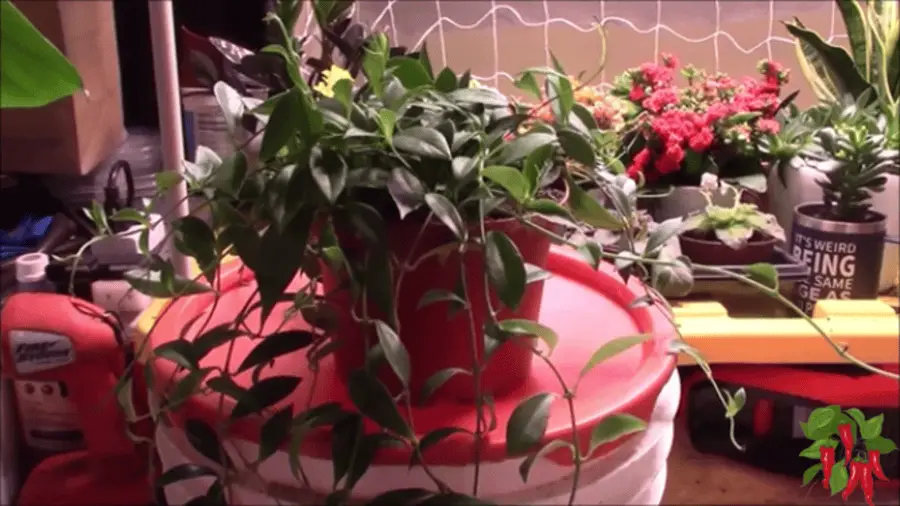
The Purple Star Lipstick Plant might not be as well-known as your everyday pothos or philodendron, but once you get to know it, you’ll see why it deserves the spotlight.
From the way it grows to the flowers it throws out, this plant’s got personality.
Botanical Classification
The Purple Star belongs to the Aeschynanthus genus, which includes all the lipstick plants.
These tropical beauties are epiphytes in the wild meaning they naturally grow on trees, not in the ground so they appreciate well-aerated soil and a little humidity.
Growth Habit
This plant came to me with long, trailing vines already in full swing, and that’s part of what makes it such a stunner.
You can let it cascade from a hanging basket, spill over the edge of a shelf, or even train it up a moss pole if you want to get fancy. It starts upright but quickly sends out vines that can get pretty long.
From the video:
“There’s some pretty long vines on this, so it’s already a hanging plant when you get it.”
It’s a fast grower once it’s happy in its space, and I haven’t even repotted mine yet so it’s still in the nursery pot, tucked into my self-watering setup.
Flowering Attributes
The real show, though, is in the blooms. Lipstick plants get their name from the way the flower buds emerge in long tubes with bright red (or sometimes pink or purple) tips that look like lipstick being twisted up.
“It’s called a lipstick plant because it makes long tubes with red ends… they kind of look like a tube of lipstick.”
The Purple Star variety is supposed to have red flowers flushed with violet, which I haven’t seen yet, but I’ve got high hopes as the days get longer.
Like most lipstick plants, it tends to flower when it’s getting the right amount of light, warmth, and moisture.
So while this plant’s already a looker with just its foliage, the flowers are the bonus that makes it a real centerpiece once they start to show.
IV. Ideal Growing Conditions
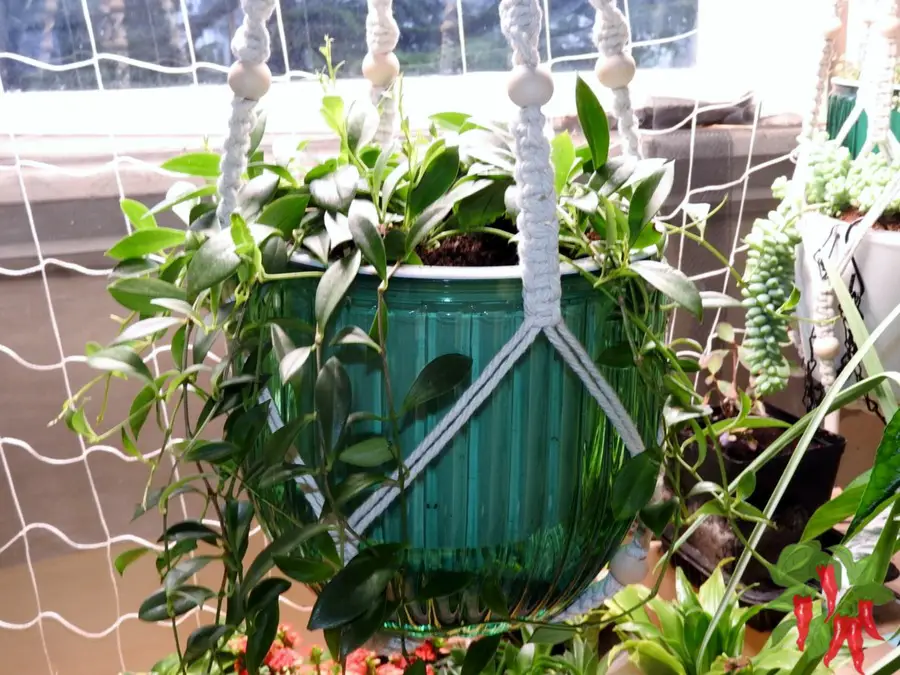
Getting your Purple Star Lipstick Plant to thrive isn’t hard. This plant’s pretty laid-back if you give it what it likes.
Think of it like setting up the perfect little tropical getaway on your windowsill: bright light, warm temps, and cozy soil. Here’s what’s been working for me so far.
Light Requirements
This plant loves bright, indirect light. It’ll tolerate a little morning sun, especially in an east-facing window, but keep it out of harsh afternoon rays as those can scorch the leaves or bleach out the color.
From the video:
“It likes light but not direct sunlight, or not for long. You could put it in an east window where it gets morning sun and it would love that.”
If you hang it too close to your grow lights (like I’ve done before), it might get more light than it wants. I use a macrame hanger to give it a bit of distance so it’s not frying under my setup.
Temperature and Humidity
This plant’s happy in average room temperatures around 65°F to 80°F is the sweet spot. It appreciates humidity, but it’s not super picky.
If you’ve got it in a kitchen or bathroom with a little natural steam, even better.
Just keep it away from cold drafts or hot air vents. Like most tropicals, it doesn’t enjoy extremes.
Soil Preferences
Lipstick plants are epiphytes, so they do best in a loose, airy potting mix that drains well. I always use coco coir for mine—it’s sustainable, holds just enough moisture, and won’t compact like regular potting soil.
“Basically, I’m gonna repot it in coco coir. That’s what I put all my plants in. Generally, I don’t use perlite.”
If you’re using a self-watering planter like I am, coco coir works beautifully with the wick system. It stays moist but not soggy—just what this plant wants.
With the right light, a little warmth, and some breathable soil, your Purple Star Lipstick Plant will be well on its way to lush growth and, hopefully, some of those showy blooms.
V. Watering and Fertilization
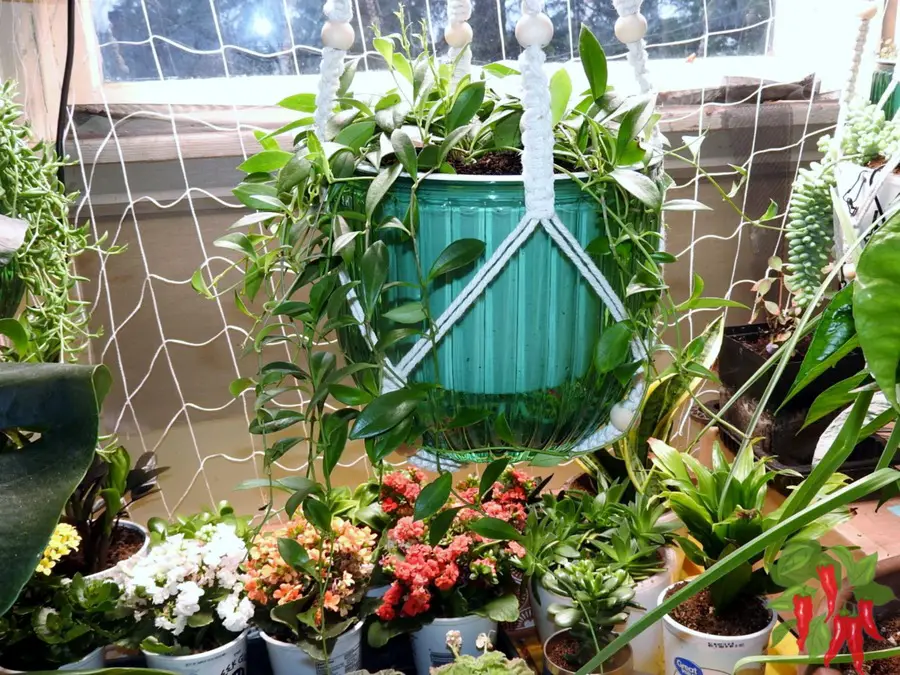
Watering is where a lot of people get tripped up with tropicals, but the Purple Star Lipstick Plant makes it pretty easy, especially if you’ve got it in the right setup.
I personally use hanging baskets with self-watering planters, and they’ve made a huge difference in keeping things consistent without the mess.
Watering Guidelines
This plant likes to stay evenly moist, but not soaked. The trick is to let the top inch or so of the soil dry out before watering again.
Overwatering can lead to root rot, while underwatering can cause wilting or leaf drop.
From the video:
“Keep it moist but not wet… The self-watering planters I really like because, for one thing, it keeps water from dripping on the floor or on the furniture in your house.”
The self-watering pot I use has a clear outer container, which lets me see exactly how much water is left, no guessing required.
The wick system slowly pulls water up into the soil, keeping the moisture level steady without overdoing it.
“It has an insert… wicks that wick up the water… because it’s translucent like this, you can tell when it needs to be watered again.”
If you’re watering by hand, give it a good soak until water runs out the bottom—then let it drain fully before putting it back in its decorative pot or hanger.
Fertilization Practices
During the growing season (spring through early fall), your Purple Star will appreciate a little boost.
A balanced liquid houseplant fertilizer, diluted to half strength, once or twice a month should be plenty.
Don’t overdo it, though. Too much fertilizer can actually slow down flowering or burn the roots. Less is more here.
Once winter rolls around, skip the feeding and just focus on light and moisture.
With a steady watering routine and the occasional dose of nutrients, your lipstick plant will stay full, lush, and ready to bloom.
And trust me, self-watering hanging baskets make the whole process a lot more hands-off and a lot more enjoyable.
Lipstick Plant Care Reference Guide
| Characteristic | Details |
|---|---|
| Common Name | Lipstick Plant |
| Botanical Name | Aeschynanthus radicans |
| Native Habitat | Tropical Southeast Asia |
| Plant Type | Evergreen trailing epiphyte |
| Growth Pattern | Trailing or cascading growth habit |
| Mature Size | 12–24 inches long |
| Watering | Keep soil lightly moist; allow top inch to dry out between waterings |
| Light/Sun Exposure | Bright, indirect light; avoid direct sun |
| Soil Type | Light, well-draining mix (peat moss or coco coir with perlite) |
| Soil pH | Slightly acidic to neutral (6.0–7.0) |
| Temperature | 65–80°F (18–27°C); protect from cold drafts |
| Humidity | High humidity preferred (50%+); misting or pebble trays helpful |
| Bloom Time & Flower Color | Blooms spring through summer; bright red tubular flowers |
| Potential Problems | Root rot, leaf drop, aphids, mealybugs, poor flowering in low light |
| Repotting | Every 2 years or when roots fill the container |
| Hardiness Zones (USDA) | 10–11 (outdoor); typically grown indoors elsewhere |
VI. Common Issues and Solutions
Even though the Purple Star Lipstick Plant is pretty easygoing, it’ll still throw you a few signals if something’s off.
I haven’t had any problems with mine so far, but here are the most common issues to watch for—and how to fix them fast.
Leaf Drop
If your plant starts dropping leaves, especially from the base of the vines, it’s usually trying to tell you it’s not getting enough light or it’s staying too wet between waterings.
Fix:
- Move it closer to a bright window with indirect light
- Let the top inch of soil dry out before watering again
- If it’s in a darker corner, try adding a grow light on a timer
A few yellowing leaves here and there is normal, but if the plant is dropping them like crazy, check those light and moisture levels.
Pests
Like most houseplants, the Purple Star can attract pests like mealybugs, spider mites, or aphids, especially if it’s under stress or crowded with other plants.
Fix:
- Wipe down leaves with a damp cloth
- Spray with insecticidal soap or neem oil
- Quarantine if it’s a new plant or you see signs of bugs (webbing, sticky spots, fuzzy white stuff)
A quick weekly check-in when you water is all it takes to catch pests early.
Root Rot
Root rot is probably the worst-case scenario, but it’s also totally preventable. It happens when the roots sit in soggy soil for too long.
This is where self-watering planters with clear bottoms really shine. You can see how much water is left and avoid overwatering completely.
Fix:
- Make sure your pot has good drainage
- Use a breathable mix like coco coir
- If rot is already setting in, take a cutting from healthy vines and start fresh
Keep an eye on these three trouble spots: leaf drop, pests, and root rot and your Purple Star will stay happy, healthy, and thriving.
VII. Pruning and Maintenance
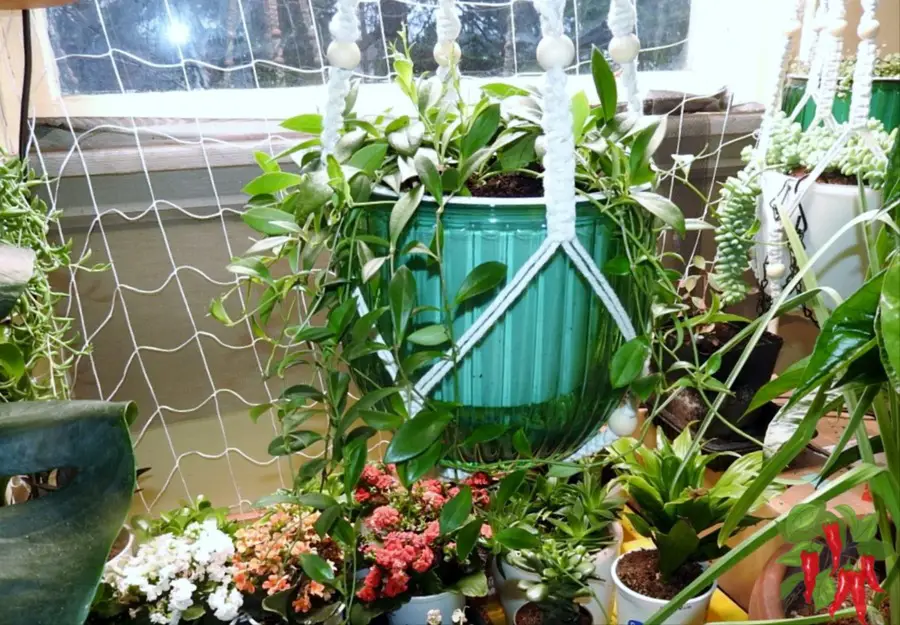
The Purple Star Lipstick Plant doesn’t need much in the way of pruning, but giving it a little regular maintenance helps it stay full, healthy, and ready to bloom.
Plus, trimming it back from time to time can actually encourage new growth and more flowers, always a win in my book.
Pruning Guidelines
If you notice any yellowing leaves or tangled vines, go ahead and snip them off with clean scissors or pruning shears.
This helps the plant focus its energy on the healthy stuff and keeps it looking tidy. You can also trim leggy stems to encourage bushier growth.
From the video:
“You can see the vines go way down… it’s already a hanging plant when you get it.”
Once those vines start really taking off, don’t be afraid to shape the plant a bit. Whether it’s hanging in a basket or trailing from a shelf, a light trim here and there keeps it balanced.
Pro tip: If you’re cutting back a long vine, try rooting the trimmed piece as a cutting. That way, you don’t waste anything, and you might end up with a second plant.
Encouraging Blooms
Lipstick plants are known for their wild, tube-shaped flowers, and while they’re not constant bloomers, you can definitely nudge them in the right direction.
Here’s what helps encourage blooms:
- Bright, indirect light—more light = more flowers
- Consistent watering—not too wet, not too dry
- Regular feeding—use a diluted balanced fertilizer during spring and summer
- Proper temperature—they like it warm and steady
From the video:
“I don’t know how long it’s gonna take for it to flower, but I expect that with spring on the way and more light… it shouldn’t be too long.”
It might take a season or two for your plant to really start blooming, but with the right conditions, those lipstick-like flowers will start to show up and they’re absolutely worth the wait.
Keep it trimmed, well-lit, and fed, and this plant will reward you with lush growth and those striking, tubular blooms.
VIII. Propagation Techniques
The Purple Star Lipstick Plant is one of those plants that practically invites you to share it.
Whether you’re looking to expand your collection or gift a piece to a friend, propagation is easy and fun.
The best method by far is stem cuttings, but let’s talk about division too—just in case you’re repotting a larger, well-established plant.
Stem Cuttings
This is the go-to method, and it’s super straightforward. When you trim a vine, you’ve already got the makings of a new plant.
Here’s how I’d do it:
- Snip a 4–6 inch stem just below a leaf node using clean scissors
- Remove the bottom set of leaves
- Place the cutting in water or a moist potting mix like coco coir
- Keep it in bright, indirect light and maintain humidity (a plastic bag or humidity dome can help)
In a couple of weeks, you should see roots forming. Once those roots are about an inch long, transplant the cutting into its own pot.
You can also tuck a rooted cutting back into the mother plant’s pot to fill it out if you want a fuller look.
Division
While it’s not the most common method for lipstick plants, division is possible if your plant is really well-established and has multiple rooted stems clumped together.
If you’re repotting anyway and notice that the plant has several individual stems with their own root systems:
- Gently separate the root ball into smaller sections
- Use your hands or a clean blade if needed
- Repot each section into its own container with fresh mix
This works best during active growth (spring or summer), and it’s a great way to give your plant a refresh while doubling your collection.
Dividing a lipstick plant (Aeschynanthus radicans) is a great way to propagate it and create new plants. Here’s how you can do it:
1. Prepare the plant: Carefully remove the lipstick plant from its pot. Gently shake off excess soil to expose the roots.
2. Divide the roots: Look for natural divisions in the root system. Use a clean, sharp knife or scissors to separate the plant into sections. Each section should have at least one or two stems and a healthy root system.
3. Replant: Plant each division in a new pot with fresh, well-draining soil. Ensure the pot has drainage holes to prevent waterlogging.
4. Care for the new plants: Place the pots in a location with bright, indirect light. Water the plants regularly, keeping the soil moist but not soggy.
This method is ideal for rejuvenating an older plant or creating multiple plants from one.
Whether you’re rooting stem cuttings in water or dividing a mature plant during repotting, propagating the Purple Star Lipstick Plant is a low-risk, high-reward move.
IX. Repotting Recommendations
The Purple Star Lipstick Plant doesn’t mind being a little snug in its pot, but like most houseplants, it’ll eventually outgrow its space.
If you start seeing roots poking out of the drainage holes or notice that it dries out super fast, it’s probably time for a new home.
When to Repot
You’ll usually only need to repot every 1–2 years, depending on how fast your plant is growing. The best time to do it is during the spring or early summer when the plant is actively putting out new growth.
From the video:
“I have not repotted it yet… I’m gonna repot it in coco coir. That’s what I put all my plants in.”
Signs it’s time to repot:
- Roots circling the bottom of the pot or growing out the drainage holes
- Soil drying out too quickly
- Plant looking a bit cramped or top-heavy
Repotting Steps
Here’s how I like to handle it:
- Choose a pot one size larger (don’t go too big!) with proper drainage holes
- Use a well-draining mix—I stick with 100% coco coir for my plants, and it works like a charm
- Gently remove the plant from its current pot, keeping the roots intact as much as possible
- Loosen the root ball slightly to help it adjust to the new soil
- Place the plant in the new pot and fill around it with fresh coco coir
- Water thoroughly and let it settle in
From the video:
“Here it is in its final resting place. It’s all potted up and ready to grow.”
If you’re using a self-watering planter, make sure the wick system is positioned properly and fill the reservoir.
I love using clear, hanging self-watering pots because I can easily see how much water is left and I don’t have to worry about spills on the floor or furniture.
A fresh pot with fresh soil gives your Purple Star Lipstick Plant room to stretch its roots and push out more of those beautiful vines.
X. Benefits of the Purple Star Lipstick Plant
The Purple Star Lipstick Plant isn’t just a looker and it’s a solid addition to any indoor plant collection with a few hidden perks.
Whether you’re into bold flowers, trailing vines, or just want something a little different, this plant brings beauty and benefits all in one tidy package.
Aesthetic Appeal
Let’s start with the obvious: this plant is a showstopper. From the lush, glossy green foliage to the dramatic trailing vines, it adds instant charm to any space.
And once those tube-like flowers start to bloom flushed in red and violet, you’ll understand why they are called lipstick plants.
From the video:
“It is a pretty plant… I think it’ll be really nice once it starts to flower.”
It works great in hanging baskets, trailing from shelves, or even as a centerpiece in a bright room.
The vines grow long quickly, and you don’t have to wait forever for it to make an impact.
Air Purification
Like many tropical houseplants, the Purple Star pulls double duty as a natural air filter.
While it may not be as famous as a peace lily or spider plant in the air-purifying department, lipstick plants still help clean indoor air by absorbing small amounts of common pollutants through their leaves and roots.
So while it’s busy looking good, it’s also doing a quiet bit of work to help you breathe easier. Not bad for a plant that takes up hardly any floor space.
With its bold style and low-maintenance care, the Purple Star Lipstick Plant is one of those rare finds that’s both functional and fabulous.
XI. Purple Star Lipstick Plant Conclusion
Adding a Purple Star Lipstick Plant to your indoor garden isn’t just about aesthetics.
It’s about discovering a plant that’s unique, rewarding, and genuinely fun to grow.
Whether it’s your first lipstick plant or just your newest addition, this one stands out with its cascading vines and vibrant blooms.
Recap of Purple Star Lipstick Plant Care Tips
Here’s a quick rundown to keep your Purple Star thriving:
- Light: Bright, indirect light is best—an east-facing window works great.
- Water: Keep the soil moist but never soggy. Self-watering planters are a game changer.
- Soil: Loose, breathable mix like coco coir—no heavy potting soil needed.
- Temperature: Average room temps (65–80°F) with a little humidity are perfect.
- Feeding: Light fertilizer during the growing season to encourage blooms.
- Propagation: Easy to grow from stem cuttings, and you can divide mature plants too.
- Pests & Issues: Watch for overwatering, occasional bugs, and low-light leaf drop.
From the video:
“It’s all potted up and ready to grow… I think it’ll be really nice once it starts to flower.”
Encouragement for Plant Enthusiasts
If you’re looking for something a little off the beaten path and something with character, color, and some real wow-factor then the Purple Star Lipstick Plant might just be your next favorite.
It’s easy to care for, fast-growing, and just unique enough to spark some curiosity from your plant-loving friends.

Purple Star (Lipstick Plant) – 6” from California Tropicals
Whether you grow it from a shelf, let it trail from a basket, or experiment with cuttings, this is a plant that makes you feel like you’re doing something special—and it doesn’t ask for much in return.
So go ahead, give it a try. Happy gardening—and don’t forget…
Stay green. 🌿
Indoor Apartment Gardening: 15 Point Comprehensive Guide
Visit my Amazon Influencer Page for videos and gardening products
Grow Your Own Garden
Visit my Amazon Influencer Page for videos and gardening products Grow Your Own Garden







